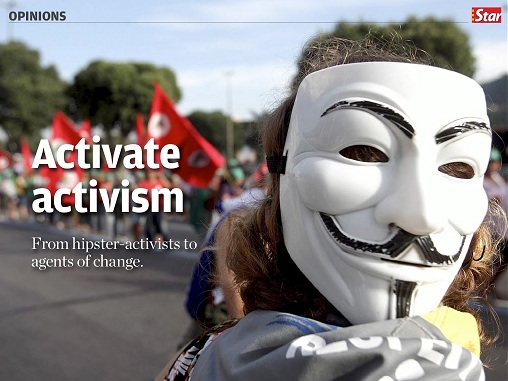 In our Selected Exhortations category, we republish interesting stuff such as must-read articles and essays not originally written exclusively for the blawg, and which have come to our attention.
In our Selected Exhortations category, we republish interesting stuff such as must-read articles and essays not originally written exclusively for the blawg, and which have come to our attention.
Please feel free to email [email protected] if you would like to reproduce your writing, but first follow our Writer’s Guide here.
This article first appeared in The Star’s iPad edition on 12 July 2012.
Amongst young, urban Malaysians, activism is on the rise. More and more are embracing activism, which is good, but not all of them are for the right reasons, which is not so good.
Hipster-activists are those who see themselves as activists because they are attracted to the ‘activist lifestyle’, instead of a particular cause. They see activism as a way to distinguish themselves from the rest of the mainstream crowd, thus making them ‘cool’ because they are different.
Like how independent music (‘indie’, for the uninitiated) is cool. Like how Polaroid cameras are cool. Like how retro is cool. Ironically, this desire to be different from the mainstream has contributed to the ‘mainstreaming’ of activism.
The same hipster-activists are seen to be involved in issues of civil liberties, environmental issues, electoral reforms, animal rights, women issues, issues facing minority communities and migrant workers and many others, depending on what is the flavor of the week. They move from one cause to another like fads, barely scratching the surface of each issue before moving on to the next.
All the while, they tweet about the forums they attended and post Instagram photos of the protests they took part in.
You would probably have heard of the term ‘clicktivism’. Clicktivism is the use of social media and online methods to promote a cause. Compare that with grassroot social activism, ‘clicktivists’ spend their activism hours online instead of on the ground. Clicktivism is a form of activism, even if hardcore social activists view it with disdain.
To be fair, not all hipster-activists are clicktivists. Some do go down to the ground. But many do not go beyond their laptops, smartphones and tablets. Clicktivsm is prevalent amongst hipster-activists and it is easy to understand why. The internet is an important medium for hipster-activists. It allows them access to information about the latest protests that will take place, forward e-mails about the latest events in the activism calendar and posts their thoughts about the most current issues.
Through the internet, hipster-activists are also able to connect with modern day icons of Malaysian activism; the Edmund Bons and the Fahmi Rezas. The rise of activism in Malaysia can be attributed to these charismatic personalities. They have ‘democratised’ activism beyond the traditional (and stereotypical) image of activists; placard-holding, headband-wearing, angry bleeding heart liberals. Now, anyone and everyone can be an activist.
It is inevitable that there are those attracted to the allure of these personalities. Hipster-activists want to embrace the ‘activist lifestyle’ for the chance to be like Edmund Bon and Fahmi Reza.
The heart of activism is the advancement of causes. Personalities are only conduits for causes. Idolisation of personalities will diminish causes and reduce them to mere excuses for activism. Causes will become secondary. The image of an activist, the acts of disobedience and the romanticism of rebellion will take precedence.
Protests will be for the sake of protesting, not to causes. Symbols; the Che Guevara t-shirt, the V for Vendetta mask, the slogans and taglines, are the hipster-activist raison d’etre – not causes.
With these superficial understanding of what activism entails, hipster-activists will leave as quickly as they came. They are just as likely to abandon activism once the shine of the ‘activist lifestyle’ wears off and they realise that these personalities whom they adored are actually quite human.
Activism in Malaysia is constantly expanding. It is evolving, from the days when activists are but a handful, to the battalion of new activists throughout the country; young, eager and ever willing to do something. The fear is that this rapid expansion is superficial in nature and that while a new breed of activists is emerging, there are also many hipster-activists in the fold.
The challenge faced by civil society used to be in looking for new blood. Now, the task at hand is to shift the focus from personalities and the ‘activism lifestyle’ into meaningful advancement of causes. The sexiness of activism may have attracted hipster-activists but civil society must be able to attract them to the causes themselves once they enter the circles. This will ensure that they stay with the cause once the initial euphoria of an ‘activist lifestyle’ has diminished.
The key is to be able to attract people through the mainstreaming of activism yet at the same time exposing these hipster-activists to the meat of the issues.
The young will always be raring to take up the mantle of the rebel as they are by nature anti-establishment. Civil society must figure out how to channel these sentiments into meaningful deeds for the betterment of the country.
Civil society must be able to turn hipster-activists into agents of change.


Nice!